Ramen noodles are a beloved staple in many households around the world. Originating from Japan, the way ramen noodles are cooked has evolved far beyond its traditional roots, becoming a global culinary phenomenon. These thin, wheat-based noodles are known for their quick cooking time and ability to absorb flavors, making them a perfect base for a variety of dishes. Whether you’re using instant noodles packets for a quick meal or crafting a gourmet bowl with fresh ingredients, ramen noodles offer endless possibilities for delicious customization.
Thank you for reading this post, don't forget to subscribe!Ramen’s popularity can be attributed to its convenience, affordability, and adaptability. Instant noodles, in particular, became a hit due to its ease of preparation and long shelf life, providing a quick meal solution for students, busy professionals, and anyone in need of a fast, satisfying dish. Beyond the convenience factor, noodles has become a canvas for culinary creativity. From traditional Japanese recipes to innovative fusion dishes, noodles can be dressed up with a variety of toppings and broths, catering to diverse tastes and dietary preferences.
The versatility of noodles means they can be enjoyed in countless ways. You can keep it simple with just broth and noodles, or you can add a range of toppings like eggs, meat, vegetables, and spices to create a more complex and hearty meal. The ability to experiment and tailor Noodles to your personal preferences is a big part of what makes it so beloved by people of all ages and backgrounds. Whether you’re a seasoned chef or a novice in the kitchen, noodles provides a delicious and satisfying culinary experience that’s easy to master and endlessly enjoyable.
Ramen Noodles are Cooked Step By Step
Cooking ramen noodles is a delightful culinary adventure that starts with boiling water in a pot on your stove. Once the water reaches a rolling boil, gently add the noodles and stir occasionally to prevent clumping. Depending on whether you’re using instant or fresh noodles, cooking times vary but typically range from 2 to 5 minutes until the noodles are tender yet firm. For instant ramen, adding the flavor packet directly into the pot or mixing it separately with hot water intensifies the taste. After cooking, top your noodles with your favorite additions like sliced green onions, a soft-boiled egg, or leftover chicken for a delicious and satisfying meal.
Ingredients and Tools Needed
Ingredients
- Ramen Noodles
- You can choose between instant ramen noodles for a quick meal or fresh ramen noodles for a more authentic taste and texture.
- Water
- Needed for boiling the noodles. The amount depends on the noodle package instructions but generally around 2-3 cups for instant noodles.
- Seasoning Packet
- If you’re using instant noodles, the seasoning packet that comes with it provides the base flavor for the broth.
- Optional Toppings
- Vegetables: Such as spinach, bok choy, carrots, mushrooms, or bean sprouts.
- Meat: Thinly sliced beef, pork, or chicken, or even seafood like shrimp.
- Eggs: A soft-boiled or poached egg adds richness.
- Others: Green onions, nori (seaweed), sesame seeds, or tofu for extra flavor and texture.
Tools
- Pot
- A medium-sized pot is ideal for boiling the water and cooking the noodles.
- Stove
- You’ll need a stove to heat the water and cook the noodles.
- Utensils
- Ladle: Useful for stirring the noodles and serving the broth.
- Chopsticks or Fork: For eating the noodles. Chopsticks are traditional, but a fork works just as well if you’re more comfortable with it.
1. Boiling the Water
Fill a Pot with Water
- Choose a pot large enough to accommodate the noodles and allow them to cook evenly.
- Fill the pot with enough water to fully submerge the noodles. For most noodles, about 4 cups (1 liter) of water is sufficient.
Bring Water to a Boil Over High Heat
- Place the pot on the stove and set the burner to high heat.
- Cover the pot with a lid to help the water reach boiling point faster.
- Monitor the pot to ensure it doesn’t boil over.
Tips for Speeding Up the Boiling Process
- Use Hot Tap Water: Start with hot water from the tap instead of cold. This can shave off a couple of minutes from the boiling time.
- Smaller Pot, Faster Boil: If you’re in a hurry and cooking just one serving, use a smaller pot to heat up less water more quickly.
- Add Salt: Adding a pinch of salt can slightly increase the boiling point of water, helping it to boil faster (though the effect is minimal, it can still help).
- Use a Kettle: If you have an electric kettle, you can boil the water there first and then transfer it to the pot.
- Flat Pot with a Larger Surface Area: Using a pot with a wider base can help the water boil more quickly due to a larger surface area exposed to the heat.
- Cover the Pot: Always use a lid. Trapping the heat inside the pot helps water reach boiling point faster.
2. Adding the Noodles
1. Open the Noodle Package
- Carefully tear or cut open the package of ramen noodles. If you’re using instant noodles, this is usually quite simple, but if you’re using fresh or dried ramen from a specialty store, be sure to handle it gently to avoid breaking the noodles.
2. Carefully Place Noodles into the Boiling Water
- With the water at a rolling boil, gently add the noodles to the pot. If you’re using a block of instant noodles, you might notice they start to soften and separate almost immediately. For fresh noodles, be a bit more cautious as they are often more delicate.
3. Stir Gently to Prevent Sticking
- Using chopsticks, a fork, or a ladle, gently stir the noodles to prevent them from sticking together. This also helps ensure they cook evenly. Stirring occasionally throughout the cooking process will help maintain the texture and prevent clumping.
3. Cooking the Ramen Noodles
Cooking ramen noodles is a simple yet crucial step that can make or break your meal. Here’s how to do it right:
Follow the Instructions for the Specific Type of Noodles
Each type of ramen noodle may have slightly different cooking instructions. Always check the package for specific details. Instant noodles typically comes with clear guidelines, while fresh ramen might require a bit more attention.
Typical Cooking Times
- Instant Noodles: Generally, instant noodles need about 3-5 minutes of cooking. This short time is perfect for a quick meal.
- Fresh Noodles: Fresh noodles, which you might find at specialty stores or make at home, usually cook faster, taking around 2-3 minutes.
Check for Doneness
To ensure your ramen noodles are cooked to perfection:
- Tender but Not Mushy: The noodles should be soft and tender when you bite into them, but they shouldn’t fall apart or become mushy. Overcooking can lead to a less enjoyable texture.
- Regularly Stir and Taste: As the noodles cook, stir them gently to prevent sticking and ensure even cooking. Taste a noodle close to the end of the cooking time to check its texture. If it’s still a bit firm, give it another minute or so.
- Timing: Set a timer based on the type of noodles you’re using. This helps avoid overcooking, especially if you get distracted.
Remember, perfectly cooked noodles are the foundation of a delicious bowl of ramen. Enjoy the process and don’t rush it!
4. Preparing the Seasoning

1. Open the Seasoning Packet
- Tear open the seasoning packet included with the instant noodles.
- Carefully pour the contents into a separate bowl.
2. Dissolve Seasoning
- For a richer flavor, add a small amount of hot water to the seasoning in the bowl.
- Stir well until the seasoning granules completely dissolve.
- This step is optional but enhances the overall taste and aroma of the ramen.
3. Ready to Use
- Once dissolved, the seasoning mixture is ready to be added to your cooked noodles.
- Pour it directly into the pot with the noodles or drizzle over the drained noodles in the serving bowl.
- Stir thoroughly to ensure the noodles are evenly coated with the seasoning.
4. Adjust to Taste
- Taste the noodles and adjust the seasoning level according to your preference.
- You can add more seasoning if you prefer a stronger flavor or adjust with additional ingredients like soy sauce or chili oil.
5. Enjoy Your Ramen!
- Incorporating the dissolved seasoning adds depth and character to your ramen dish.
- Serve hot and enjoy your delicious bowl of homemade ramen noodles!
5. Combining Noodles and Seasoning

After cooking the noodles to your desired doneness, it’s time to bring everything together for that delicious ramen experience:
1. Drain or Leave in Water
- Decide whether you prefer your ramen with a bit of broth or a drier texture.
- To keep more broth, leave the noodles in the water. For a drier dish, drain the noodles using a colander.
2. Adding Seasoning
- If you’re using instant ramen, open the seasoning packet.
- For a richer flavor, you can dissolve the seasoning in a separate bowl with a small amount of hot water before adding it to the noodles.
3. Mixing It All Together
- Sprinkle the seasoning directly into the pot with the noodles.
- Use chopsticks or a fork to gently stir everything together, ensuring the noodles are evenly coated with the seasoning.
- This step is crucial to distribute the flavors throughout the dish.
4. Adjusting to Taste
- Taste your ramen and adjust seasoning if needed. You can add more seasoning or a dash of soy sauce for extra depth.
- Consider adding a bit of broth or hot water if the noodles seem too dry or if you prefer a soupier consistency.
5. Final Touch
- Once everything is mixed to your liking, you’re ready to serve!
- Transfer the ramen to a bowl, ensuring to include all the tasty toppings you’ve prepared.
Enjoy your homemade ramen, tailored just the way you like it!
6. Adding Toppings

1. Suggestions for Popular Toppings
- Soft-Boiled Egg: Cook eggs until whites are set but yolk is still runny. Peel and cut in half just before serving.
- Sliced Green Onions: Wash thoroughly, trim roots, and slice thinly on a diagonal for a fresh, oniony crunch.
- Cooked Meat: Use leftover grilled chicken, pork belly, or thinly sliced beef. Heat through before adding to noodles.
- Vegetables: Steam or stir-fry vegetables like spinach, bean sprouts, or mushrooms until tender-crisp.
- Seaweed: Use dried seaweed sheets (nori) torn into small pieces for a salty, umami boost.
2. How to Prepare and Add Toppings for Extra Flavor and Nutrition
- Soft-Boiled Egg:
- Boil water, gently lower eggs into water, and simmer for 7 minutes.
- Transfer eggs to ice water to stop cooking. Peel and slice before adding to ramen.
- Sliced Green Onions:
- Rinse green onions under cold water and pat dry.
- Trim off roots and any wilted parts, then slice thinly on an angle.
- Cooked Meat:
- Reheat leftover meat in a skillet with a bit of oil until warmed through.
- Season lightly with salt and pepper if needed before placing on top of ramen.
- Vegetables:
- Steam or quickly stir-fry vegetables until tender but still vibrant in color.
- Season with a pinch of salt or soy sauce for added flavor.
- Seaweed:
- Tear or cut dried seaweed sheets into small pieces.
- Sprinkle over the ramen just before serving to retain crispness.
3. Tips for Extra Flavor and Nutrition
- Balancing Flavors: Consider adding a squeeze of lime or a dash of sesame oil for depth.
- Freshness: Use fresh ingredients whenever possible for optimal taste and nutrients.
- Variety: Mix and match toppings to suit your preferences and dietary needs.
By adding these toppings thoughtfully, you can elevate your ramen into a hearty, flavorful meal that satisfies both cravings and nutritional needs.
7. Serving the Ramen
1. Transfer Noodles to a Bowl
- Using tongs or a ladle, carefully transfer the cooked noodles from the pot to a serving bowl.
- Allow any excess water to drain off, depending on your preference for brothiness.
2. Arrange Toppings Neatly
- Begin by placing any prepared toppings such as sliced green onions, cooked meat slices, or vegetables on top of the noodles.
- For visual appeal, arrange toppings in a balanced manner across the surface of the noodles.
3. Tips for Enhancing the Ramen Experience
- Choose the Right Bowl: Opt for a traditional ramen bowl if available, which is wider and deeper than regular bowls, allowing space for toppings and broth.
- Use Chopsticks: Embrace tradition by serving and eating ramen with chopsticks. They allow for better control when picking up noodles and toppings, enhancing the dining experience.
- Garnish with Fresh Herbs: Sprinkle freshly chopped cilantro, basil, or parsley on top for a burst of color and freshness.
- Add Texture: Consider adding crispy elements like fried shallots, sesame seeds, or crushed nori (seaweed) for added texture and flavor contrast.
- Serve with Condiments: Offer condiments like chili oil, soy sauce, or sesame paste on the side for diners to customize their ramen according to taste preferences.
By following these serving tips, you’ll not only enhance the visual appeal of your ramen but also elevate the overall dining experience, making it more enjoyable and satisfying for everyone at the table.
4. Tips and Tricks for the Perfect Ramen
Adjusting Flavor and Spice Levels
- Taste as You Go: Regularly sample the broth and noodles as they cook. Adjust seasoning with soy sauce, miso paste, or chili oil to suit your taste.
- Balancing Flavors: Enhance richness with a dash of sesame oil or depth with a splash of rice vinegar. Experiment with citrus zest for a refreshing twist.
- Heat Control: For a spicier kick, add fresh chili peppers or chili flakes gradually. Alternatively, balance heat with a dollop of honey or a sprinkle of sugar.
Customizing with Your Favorite Ingredients
- Protein Power: Amp up protein by adding grilled chicken, shrimp, or tofu cubes. Opt for thinly sliced beef for a savory touch.
- Veggie Variety: Load up on freshness with crunchy bean sprouts, spinach, or bok choy. Consider adding mushrooms or corn for added texture.
- Egg-cellent Choices: Perfect your ramen with a soft-boiled egg for a creamy finish. Marinate in soy sauce or mirin for extra flavor.
Making Your Own Broth for a Homemade Touch
- Starting Base: Begin with a rich chicken, pork, or vegetable broth. Simmer bones or vegetables with aromatics like ginger, garlic, and onion for depth.
- Slow Simmer: Allow flavors to meld over low heat for at least an hour, skimming impurities as they rise.
- Enhancing Umami: Boost umami with kombu (dried kelp) or bonito flakes. For a vegan twist, utilize dried mushrooms or miso paste.
- Straining Perfection: Strain broth through a fine mesh sieve for a silky texture. Customize with soy sauce, mirin, or sake for a nuanced finish.
Personal Touch
- Share a personal anecdote about a memorable ramen experience
- Highlight the joy of cooking and sharing ramen with loved ones
Ramen noodles offer a delightful canvas for culinary creativity. Don’t hesitate to explore various styles and recipes—from traditional Japanese to inventive fusion dishes. Whether you prefer classic tonkotsu or spicy miso, there’s a ramen style waiting to be your new favorite.
Invite friends and family to join in the experience. Sharing a steaming bowl of homemade ramen isn’t just about the food; it’s about creating memories together. Experiment with different toppings, broths, and seasonings to tailor each bowl to your taste. The joy of discovering new flavors and perfecting your ramen-making skills is something worth savoring with loved ones.
So, gather your ingredients, boil that water, and dive into the world of ramen. Whether you’re a novice or a seasoned chef, every bowl is a chance to craft something delicious and share it with those who matter most. Enjoy the journey—and the noodles!
Additional Resources
Recommended Recipes and Cookbooks
- “Japanese Soul Cooking: Ramen, Tonkatsu, Tempura, and More from the Streets and Kitchens of Tokyo and Beyond” by Tadashi Ono and Harris Salat: A comprehensive guide to Japanese comfort food, including ramen recipes.
- “Ivan Ramen: Love, Obsession, and Recipes from Tokyo’s Most Unlikely Noodle Joint” by Ivan Orkin and Chris Ying: An inspiring story of a New Yorker’s journey to becoming a ramen chef in Tokyo, with delicious recipes.
- “Simply Ramen: A Complete Course in Preparing Ramen Meals at Home” by Amy Kimoto-Kahn: A beginner-friendly cookbook offering easy-to-follow recipes for homemade ramen.
Online Communities and Forums for Ramen Enthusiasts
- Reddit /r/ramen: A popular subreddit where ramen lovers share recipes, tips, and photos of their homemade creations.
- The Ramen Rater Blog: An extensive blog covering reviews of instant noodles from around the world, along with recipes and cooking tips.
- Eat Your Ramen: A Facebook group dedicated to discussing all things ramen, from recipes to restaurant recommendations.
Local Ramen Shops and Events to Explore
- (Local City) Ramen Festival: Check local event listings for annual ramen festivals featuring various ramen vendors and activities.
- (Local Ramen Shop): Highlight a favorite local ramen shop known for its authentic flavors and inviting atmosphere.
- (Local Asian Supermarket): Explore the noodle aisle for a variety of ramen noodles and ingredients to experiment with at home.
These resources will enhance your ramen cooking experience and connect you with a vibrant community of ramen enthusiasts both online and locally.
If you want to read why Ramen bad for you……






